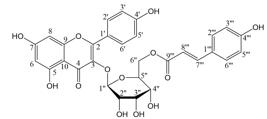Abstract
Tiliroside is a glycosidic flavonoid present in many plants species including Helicteres velutina K. Schum (Malvaceae sensu lato), commonly known in Brazil as “pitó”. This molecule has been shown to have many biological activities, however no study has been carried out to investigate the toxicity of this substance. The present work aimed to evaluate the possible cellular toxicity in silico, in vitro and ex-vivo of the kaempferol-3-O-β-D-(6”-E-p-coumaroyl) glucopyranoside (tiliroside), through chemical structure analysis, toxicity assessment and predictive bioactive properties, using human samples for in vitro and ex-vivo tests. The in silico analysis suggests that tiliroside exhibited great absorption index when penetrating biological membranes. In addition, it also displayed considerable potential for cellular protection against free radicals, and anticarcinogenic, antioxidant, antineoplastic, anti-inflammatory, anti-hemorrhagic and antithrombotic activities. The assessment of the hemolytic and genotoxic effects of tiliroside showed low hemolysis rates in red blood cells and absence of cellular toxicity in the oral mucosa cells. The data obtained indicate that this molecule could be a promising therapeutic approach as a possible new drug with biotechnological potential.
Keywords:
hemolytic; genotoxicity; toxicity; Helicteres velutina

 Thumbnail
Thumbnail
 Thumbnail
Thumbnail
 Thumbnail
Thumbnail


